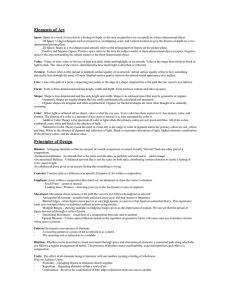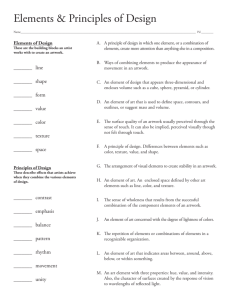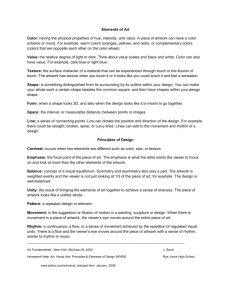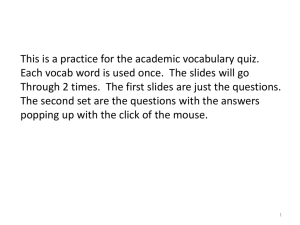VOCABULARY AND DEFINITIONS J. GILL
advertisement
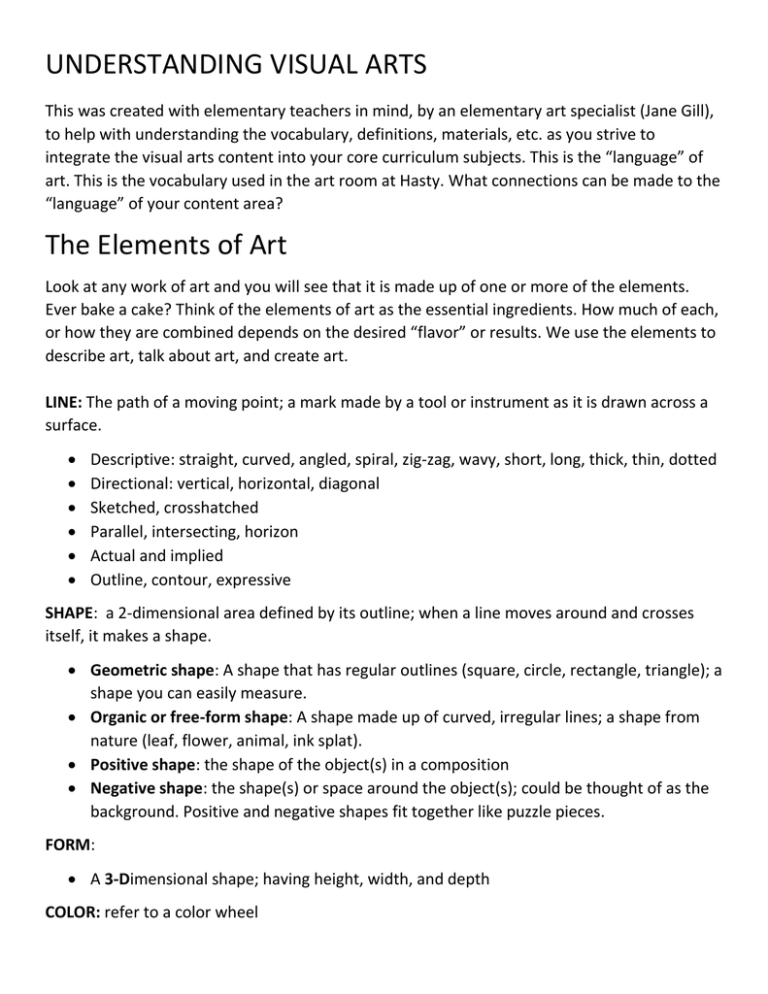
UNDERSTANDING VISUAL ARTS This was created with elementary teachers in mind, by an elementary art specialist (Jane Gill), to help with understanding the vocabulary, definitions, materials, etc. as you strive to integrate the visual arts content into your core curriculum subjects. This is the “language” of art. This is the vocabulary used in the art room at Hasty. What connections can be made to the “language” of your content area? The Elements of Art Look at any work of art and you will see that it is made up of one or more of the elements. Ever bake a cake? Think of the elements of art as the essential ingredients. How much of each, or how they are combined depends on the desired “flavor” or results. We use the elements to describe art, talk about art, and create art. LINE: The path of a moving point; a mark made by a tool or instrument as it is drawn across a surface. Descriptive: straight, curved, angled, spiral, zig-zag, wavy, short, long, thick, thin, dotted Directional: vertical, horizontal, diagonal Sketched, crosshatched Parallel, intersecting, horizon Actual and implied Outline, contour, expressive SHAPE: a 2-dimensional area defined by its outline; when a line moves around and crosses itself, it makes a shape. Geometric shape: A shape that has regular outlines (square, circle, rectangle, triangle); a shape you can easily measure. Organic or free-form shape: A shape made up of curved, irregular lines; a shape from nature (leaf, flower, animal, ink splat). Positive shape: the shape of the object(s) in a composition Negative shape: the shape(s) or space around the object(s); could be thought of as the background. Positive and negative shapes fit together like puzzle pieces. FORM: A 3-Dimensional shape; having height, width, and depth COLOR: refer to a color wheel Primary colors: red, yellow, blue are what you need to make all the other colors. Secondary colors: orange, purple, green; made by mixing two primary colors. Intermediate or tertiary colors: made by mixing a primary with a secondary. Warm colors, red/yellow/orange, create a feeling of warmth and energy. They appear to come forward. Cool colors, blue/green/violet, create a calm, peaceful mood. They appear to recede. Complementary colors: a color scheme using colors located directly across from each other on the color wheel. They create “eye-excitement” (a vibration) and strong contrast. Use a color’s complement to dull or gray that color (lower its intensity). Hue: a pure, unmixed color. Intensity: the full concentration of a color; how bright or dull a color is (this is different from value, which is how light or dark a color is). Analogous colors: are several colors that are next to each other on the color wheel. They share one color in common and can mix with each other w/o turning dull or gray. Monochromatic: a color scheme using tints and shades of one color Dominant: the color a viewer sees most in an artwork TEXTURE: Tactile texture: the way the surface of a real object feels when you touch it. Visual texture: the way a surface looks as if it would feel; the appearance of texture on a drawn or painted surface. VALUE: The lightness or darkness of a color. Tint: A lighter value of a color, created by mixing white and the color. Shade: A darker value of a color, created by mixing black and the color. Blending: mixing or smudging areas to create gradual value changes. SPACE: The area around, between, and within objects OR the illusion of depth in artwork Negative space: the spaces between and around objects (objects are the positive shapes) Depth: the appearance of space or distance in a flat, 2-D artwork. Overlapping: objects that are partly in front of or behind other objects. Foreground (closest to the viewer), middle ground (in the middle), background (the part of an artwork that seems farthest from the viewer) Atmospheric perspective: a spatial technique using different values to show distance. Linear perspective: a spatial technique used in 2-D artwork where parallel lines meet at a vanishing point on the horizon line. The Principles of Design Think of the Principles of Design as the recipe, or how the elements are used or combined to produce the desired result. BALANCE: Symmetrical balance: The type of balance created when the left and right sides of an artwork match, or are the same. Radial balance: A type of balance where a pattern extends from the center of the artwork, like spokes on a wheel or a spider web. Asymmetrical balance: A type of balance achieved when two sides of an artwork are different but visually equal in weight. (Picture one big object, off-center, balanced by a medium and small object). CONTRAST: a sharp difference between two things, making one or both stand out. EMPHASIS: the special importance given to one part of an artwork; focal point. PATTERN: a design made up of repeated lines, shapes, or colors. RHYTHM: the VISUAL BEAT created by repeated lines, shapes, colors or patterns. MOVEMENT: the way a viewer’s eyes travel from one element to another in an artwork. PROPORTION: the relationship of one part to another or to the whole (realistic proportion, exaggerated proportion, facial proportion, body proportion) UNITY: a sense that the artwork is complete. VARIETY: concerned with differences to add interest (in size, height, color, value, etc.). Art can be categorized by subject matter. PORTRAIT: artwork that shows what a person, a group of people, or an animal looks like. LANDSCAPE: artwork showing an outdoor scene. SEASCAPE: artwork that shows the sea and sky CITYSCAPE: artwork that shows city buildings, streets, skyline ARCHITECTURE: artwork showing a particular building STILL-LIFE: objects arranged together in an interesting way; objects that don’t move. SCULPTURE: a 3-dimensional art form Art can be categorized by medium, or the materials used. DRAWING: pencils, charcoal, markers, pastel chalks PAINTING: tempera, watercolor, acrylic, oil PRINTMAKING: brayer, ink, plate, edition SCULPTURE: clay, wood, marble, metal, fiberglass, paper, wire, natural materials COLLAGE: artwork made by cutting and gluing materials (paper, yarn, cloth) onto a surface WEAVING: a cloth created by fibers that have been interlaced or woven together. TECHNOLOGY: photography, video, computer art Art can be categorized by style: REALISTIC or REPRESENTATIONAL: looks like the actual object in real life ABSTRACT: art that does not look realistic; recognizable objects are shown in unusual ways NON-OBJECTIVE: emphasis on elements only and how they are arranged (you don’t recognize any specific object, only lines, shapes, colors, etc.) EXPRESSIONISM: emphasis is on intense feeling or mood rather than realistic depiction. SURREALISM: realistic objects portrayed in a fantasy or dreamlike way. Miscellaneous terms: SYMBOL: a picture or object that stands for an idea. DESIGN or COMPOSITION: An arrangement of independent parts to form a coordinated whole MOOD: the way an artwork makes you feel CRAFT: a special manual skill CRAFTSMANSHIP: how well one performs a skill; using materials correctly; caring and taking time to do the work well PORTFOLIO: a collection of work or the container that holds the collection LET’S INVESTIGATE ART: DESCRIBE: what do you actually see? Is it 2-D or 3-D? What is the art medium (materials), type of artwork (drawing, painting, print, etc.), style, and subject matter? Who is the artist? (correct pronunciation), title, size, time and place created, biographical/historical/cultural background information Learning to look 10x2 exercise: list 10 things you see in the artwork (words or short phrases); now, list 10 more things. This exercise forces you to look deeper, notice details, relationships, meanings, etc. ANALYZE: separate the whole into its parts. Learn to talk about own work and that of others. Identify the elements and how they are used according to the principles in the piece. Compare and contrast with other pieces. Explain why the artist made specific choices; what effect it has on the piece; why it is unique or what its special qualities are. INTERPRET: discover meaning, intention, message, mood, symbols, why you might react in a certain way JUDGE: form an opinion based on the description, analysis, value and significance of the piece (not just “I like it”).

